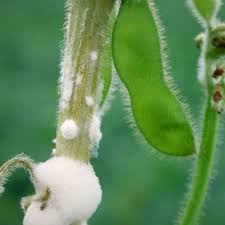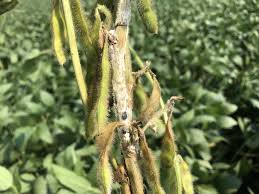White mold scientifically known as Sclerotinia sclerotiorum is a very common and yield-limiting disease affecting dry bean production in the Northarvest growing region. Nearly complete yield loss can occur in severe cases and if no management tools are used.
It can be especially devastating when cool, wet weather occurs at flowering. Infected plant tissues will turn tan to dry-bone color, may be covered with “white mold” and will shred toward the end of the season.
Within diseased tissues, the causal fungal pathogen produces hardened fungal structures called sclerotia. Sclerotia have a black exterior and a white to the pinkish interior, and they take on the shape of the plant tissue in which they are produced.
When white mold-infested tissue shatters or decays, sclerotia are released into the soil, where they serve as resting structures for initiating new disease outbreaks in future growing seasons. Sclerotia can survive in the soil for many years.
When the soil surface is wet in the spring and summer, sclerotia will form tiny mushroom-like bodies (apothecia) that liberate wind-dispersed ascospores. Ascospores do not directly infect living tissue; rather, they colonize bean blossoms and use them as an energy source to become established on the plant.
As a consequence, dry edible beans often are considered at risk for white mold only after flowering, and similarly, fungicide applications are recommended only during flowering. Once the pathogen has colonized bean dead flower tissues, it easily can invade healthy green tissue and quickly damage the plant.
In wet weather, infected tissues are tan and soft with tufts of fluffy white fungal growth. Eventually, sclerotia will form, leaves of infected plants turn yellow and infected branches or the whole plant may wilt.
In dry weather, affected stems have a bleached or whitish appearance. The epidermis of such tissues peels easily and appears shredded, and sclerotia may be found inside. Infected seeds are discolored, chalky, and lightweight, and sclerotia may be found in the pod.
Read Also: Anthracnose Disease on Beans Production: Identification & Control
White Mold Disease Management

Crop rotation: Avoid short rotations or rotations with other susceptible crops, especially sunflower, canola, and soybean. Although crop rotation is important, it should be used in conjunction with other management tools because the sclerotia can survive for several years in the soil.
Foliar fungicides: Many foliar fungicides are available and can provide some management of the disease. However, management of white mold is simply that; fungicides can reduce disease severity sharply but do not provide complete control of white mold.
Because the pathogen uses flower petals as a food source, early flowering is generally the best time to apply fungicides, but the initial application can be delayed if the weather does not favor disease development at flowering. Dry beans are at the highest risk of white mold when the soils are moist going into flowering and cool, wet weather occurs during flowering.
However, white mold also can develop in the absence of significant rainfall if soils have been sufficiently moist to facilitate the development of the mushroom-like apothecia and temperatures are cool with heavy dew in the mornings.
Additionally, the microclimate within the canopy will impact disease; high canopy density within the rows and a densely closed-canopy favor infection and disease development.
A second application may be recommended 10 to 14 days after the first application if conditions favoring the disease (cool and wet) persist.
Although additional applications may limit additional infections, the most devastating lesions occur in the early flowering stages, and preventing them is critical.
Good canopy penetration of the fungicide is required to ensure flowers and lower stems are protected.
Biological control: Commercial production of a fungus that attacks sclerotia, Coniothyrium minitans, also is available. Coniothyrium minitans need to be incorporated into the soil, preferably late in the fall.
Cultural control: Increasing row spacing may help enhance drying and subsequently help the crop escape severe infection in years when conditions are marginal for white mold development.
Weed control: Many broadleaf weeds are hosts to the pathogen. Effective weed control every year in each field is important for limiting the buildup of the pathogen for future bean crops.
Read Also: How To Generate Money From Inert Wastes

